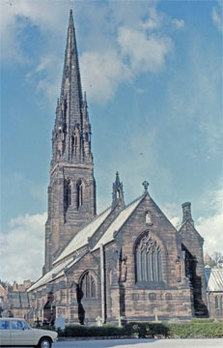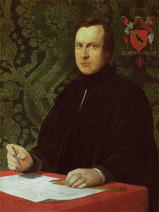|
St Patrick's Church, Colebrook
Australia |
|
|
CHURCH ESSAY & GUIDE
We strongly recommend that you read our essay on St Patrick's Church before undertaking a tour of the building. It can be downloaded HERE. It would be of use to take on your tour, along with the guide, HERE. OPENING TIMES St Patrick's Church is normally open on the first Sunday of every month between 2pm and 4pm. |
You are perhaps wondering why such an ambitious building stands on its dramatic hillside site above the little village of Colebrook. In 1853, when construction of a Catholic church was being considered, the growing settlement, situated on one of two roads linking Hobart and Launceston, seemed destined to become an important centre in southern Tasmania. But that never eventuated.
|
The 1843 designer of this church was Augustus Welby Northmore Pugin (1812–1852), an amazingly prolific creative genius and the supreme English designer of the early-Victorian era. In a tragically short working life Pugin conjured up over a hundred buildings and untold thousands of designs for metalwork, furniture, ceramics, textiles, wallpaper, stained glass, jewellery, book illustrations and flat decoration. He is best known for a series of books which irrevocably altered the course of nineteenth-century architecture and design.
Pugin’s inexhaustible creativity was fuelled by a passionately-held belief that the moral, social and spiritual condition of his time could only be improved through a complete revival of the physical and religious fabric of medieval England. And so St Patrick’s, Colebrook, in its plan, composition, detail and liturgical furnishings, is a scholarly yet totally original evocation of an English village church of circa 1320. |

Pugin’s vision to resurrect the physical and spiritual life of the medieval English church was only fully shared by a handful of his close friends. One of them was Robert William Willson (1794–1866), priest in charge of the Nottingham Catholic mission, whose unremitting labours on behalf of the sick and the needy regardless of creed had earned him the respect of all the townspeople.
In 1842 Willson’s noble-hearted benevolence made him the ideal choice as first Bishop of Hobart Town, heading a poor Catholic flock—over half of them convicts—scattered across Van Diemen’s Land (later re-named Tasmania). When Pugin first learnt of Willson’s appointment as bishop he exclaimed with great energy, “only think, the right thing will find its way at the antipodes”! Here was an opportunity to work towards their shared vision for a better society.
In 1842 Willson’s noble-hearted benevolence made him the ideal choice as first Bishop of Hobart Town, heading a poor Catholic flock—over half of them convicts—scattered across Van Diemen’s Land (later re-named Tasmania). When Pugin first learnt of Willson’s appointment as bishop he exclaimed with great energy, “only think, the right thing will find its way at the antipodes”! Here was an opportunity to work towards their shared vision for a better society.
Pugin and Willson worked hand-in-hand towards realising their vision. The faithful of Van Diemen’s Land would be baptised in a Pugin font and attend Mass celebrated in a Pugin-designed and furnished church by a priest wearing Pugin vestments and using Pugin altar vessels. Then at life’s end they would be buried in the shadow of a Pugin churchyard cross, their final resting place marked by a Pugin headstone.

Churches were to be built from three perfect little scale models brought out by Willson in 1844. They had been designed by Pugin and constructed in England by craftsmen in the employ of George Myers, his favoured builder. St Patrick’s, constructed between 1855 and 1857, is in fact copied from one of those models, with some of the more complex carved details copied from full-size limestone exemplars made by Myers’ men.
St Patrick’s Church is a building of the utmost importance. Its unique design is the most radical of Pugin’s essays in the provision of cheap commodious churches for poor clients. In terms of structural and decorative elaboration it lies at one end of the spectrum of all his church designs. At the other end you find St Giles’, Cheadle, Staffordshire, widely regarded as England’s finest nineteenth-century church.
St Patrick’s Church is a building of the utmost importance. Its unique design is the most radical of Pugin’s essays in the provision of cheap commodious churches for poor clients. In terms of structural and decorative elaboration it lies at one end of the spectrum of all his church designs. At the other end you find St Giles’, Cheadle, Staffordshire, widely regarded as England’s finest nineteenth-century church.
Pugin’s Australian legacy is all around us. You can probably visualise a building with pointed arches to the doors and windows—most likely a church—near where you live. The greatest influence on why it was built in this style, called Gothic, was undoubtedly Pugin’s writings. His dream of achieving a better, more just, society may have faltered, but the exquisitely beautiful designs he created have enriched our antipodean culture.





